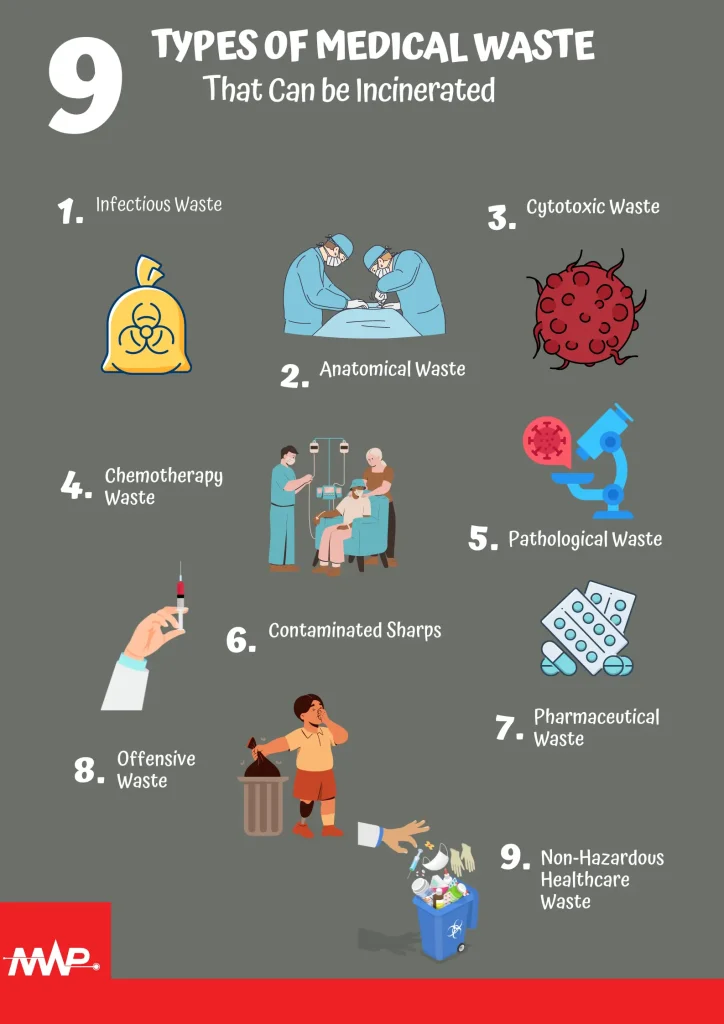How a Medical Waste Incinerator Works

There are two main treatment options to sterilize regulated medical waste. Excessive heat and chemical agents can be used separately or in combination to kill infectious organisms. A medical waste incinerator uses heat and a chemical reaction (oxidation) to treat waste.
Medical waste is created with nearly every patient that is seen in clinics, hospitals, and other healthcare offices across the country. Managing medical waste is essential to maintaining clean medical facilities and protecting the public. Only a small percentage of this waste is considered “regulated medical waste,” requiring specialized disposal to render it non-infectious.
What is a Medical Waste Incinerator?
A medical waste incinerator is a high-temperature furnace that burns waste in a combustion chamber. The process is the safest and most effective treatment for medical waste. Alternatives to incineration include autoclaving, chemical treatments, and ozone disinfection. These options are beneficial, but cannot completely destroy certain medical wastes, including pharmaceuticals and some pathological waste.

Medical waste that can be incinerated includes:
- Infectious waste
- Anatomical waste
- Cytotoxic waste – medication or materials that have come into contact with substances that are carcinogenic
- Chemotherapy waste
- Pathological waste
- Contaminated sharps
- Pharmaceutical waste
- Offensive waste – non-infectious waste that is offensive due to odor
- Non-hazardous healthcare waste
Incineration leaves behind only trace residue, referred to as ash or dust. The ash is shipped to a Subtitle D landfill for non-infectious waste.
Types of Medical Waste Incinerators
There are three main types of medical waste incinerators. We will take a closer look at each type below.
Controlled Air Incinerator
The majority of medical waste incinerators fall into this category. This method may also be referred to as starved-air incineration, two-stage incineration, or modular combustion. It works in two steps.
First, waste is fed into the primary or lower combustion chamber. Combustion air enters the chamber from beneath the burning waste to dry and vaporize the materials. Second, excess air is added to complete combustion. Waste feed and ash removal may be manual or automatic.
Excess Air Incinerator
Excess air incinerators are typically smaller units that may be referred to as batch incinerators, multiple chamber incinerators, or retort incinerators. They are a compact cube with a series of internal chambers.
Waste is fed into the combustion chamber and an afterburner is ignited to bring the secondary chamber to its target temperature. The waste materials are dried, ignited, and combusted. Secondary air is added through a flame port and mixed with volatile components in the secondary chamber. Gases exit the chamber to an air pollution control device. When the chamber is cooled, ash can be manually removed.
Rotary Kiln Incinerator
Rotary kiln incinerators have a primary chamber for heat and volatilization and a secondary chamber where the combustion of the volatile fraction is completed. The primary chamber is inclined and rotates to pull waste materials from the feed end to the ash discharge end. Combustion air enters through a port in the primary chamber. An auxiliary burner starts combustion and maintains temperature.
Why is Incineration Important?
Human health depends on our ability to properly dispose of potentially infectious or hazardous chemical waste. Whether it is used vaccination needles, trace chemicals leftover from cancer treatments, or human tissue removed from surgeries; safe disposal is critical in preventing the spread of disease or toxin contamination. Incineration safely treats medical waste and is required by most states.
Environmental Effects of Incineration
Though incineration is effective, there are environmental concerns to consider. Incinerators emit dioxin, mercury, and other heavy metals into the air. These pollutants damage air quality and can negatively impact human health. Incinerators also use a significant amount of fuel and generate excessive greenhouse gases.
Luckily, medical treatment technologies continue to advance and provide sustainable options for the future. Gas cleaning equipment makes incinerators safer and able to comply with international emission standards. Alternative waste treatment options such as autoclaving, microwaving, and steam treatments minimize the formation and release of chemicals and harmful emissions.
Manage Medical Waste Responsibly with Medical Waste Pros
Medical Waste Pros uses best practices to safely dispose of medical waste. We are committed to providing affordable services that support our customers and the environment. Give us a call at (888) 755-6370 or fill out the form to learn more about our medical waste disposal services and receive free quotes from providers near you.










